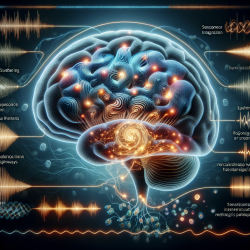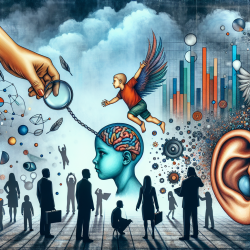Introduction
The field of speech-language pathology continually seeks innovative approaches to better understand and address communication disorders. Recent research, such as the study titled "The Application of EEG Mu Rhythm Measures to Neurophysiological Research in Stuttering," provides valuable insights into the neurophysiological underpinnings of stuttering. This blog explores how practitioners can leverage these findings to enhance their therapeutic approaches and encourages further research in this promising area.
Understanding EEG Mu Rhythms
Mu rhythms, identified through electroencephalography (EEG), are characterized by spectral peaks in the alpha (8–13 Hz) and beta (14–25 Hz) frequency bands. These rhythms originate from premotor and motor regions and are influenced by basal ganglia and sensorimotor functions. The study highlights the sensitivity of mu-alpha to basal ganglia-based inhibitory signals and sensory-to-motor feedback, while mu-beta is responsive to timing changes and motor-to-sensory projections.
Key Findings and Implications
The research provides evidence that mu rhythms can differentiate stuttering from non-stuttering individuals with high temporal precision. Notably, the study found reduced mu-alpha suppression in individuals who stutter during a non-word repetition task, indicating deficits in working memory. These findings suggest that mu rhythms offer a rich window into observing neurophysiological deficits associated with stuttering in both speech and cognitive tasks.
Applications in Speech Therapy
For practitioners, these insights can inform data-driven therapeutic strategies. By understanding the neurophysiological processes underlying stuttering, therapists can tailor interventions to target specific deficits. For instance, therapies that enhance sensorimotor integration and timing may prove beneficial. Additionally, monitoring mu rhythm activity could serve as a biomarker for assessing therapy progress and outcomes.
Encouraging Further Research
While the study provides a solid foundation, it also highlights areas for further exploration. Future research could focus on refining EEG techniques to improve temporal resolution and apply these findings to younger populations. Investigating the role of mu rhythms in other cognitive functions related to stuttering, such as attention and executive function, could also yield valuable insights.
Conclusion
The application of EEG mu rhythm measures offers a promising avenue for advancing our understanding of stuttering. By integrating these findings into practice, speech-language pathologists can enhance therapeutic outcomes and contribute to a deeper understanding of this complex disorder.
To read the original research paper, please follow this link: The Application of EEG Mu Rhythm Measures to Neurophysiological Research in Stuttering.










